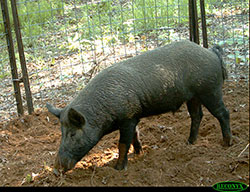
Call them feral swine, wild boar, wild hogs, or razorbacks: they are one of the most destructive invasive animal species in the U.S., and they are spreading to more and more of the country and have now spread into our area. There have been 8 sightings in Mitchell County and 6 in Yancey. According to the U.S. Department of Agriculture, hogs cause approximately $2.5 billion in damages each year by rooting and trampling farm and forest lands, eating crops, and transmitting diseases and parasites.
European settlers first brought Sus scrofa—the species that includes both domestic pigs and wild hogs—to what is now the continental U.S. in the 1500s as a food source. As settlers expanded into the U.S., pigs occasionally escaped captivity, where they returned to their wild roots. Subsequently, in the 1900s, European or Russian boars were introduced to the U.S. for sport hunting. Interbreeding between escaped domestic pigs and boars has created hybrids with the strongest characteristics of each.
Wild hogs have several qualities that have allowed the species to take hold. Allowed to graze freely in the wild, feral swine can grow to larger sizes than domesticated pigs with controlled diets. Attributes like intelligence and a strong sense of smell allow wild hogs to survive well in the wild. Because they do not have substantial predators outside of humans and can live comfortably in a variety of climates, there is little to stop their continued spread.
Perhaps most significantly, wild hogs are very fertile. Each litter of newborn hogs averages around five offspring but can reach as many as 12, and sows can give birth to a litter up to twice per year. In sum, the species’ strength and rapid reproductive rate have led to exponential population growth.
In North Carolina there have been 655 feral hog reports in 85 counties.
Photo courtesy of US Dept. of Agriculture





